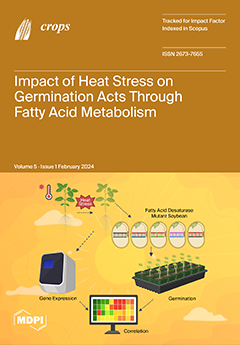With the search for alternative pest management strategies due to the concerns associated with synthetic pesticides, botanicals have been of increasing interest. However, the potential of plants such as soybean (
Glycine max) as biopesticides is less known. Hence, this study assessed
[...] Read more.
With the search for alternative pest management strategies due to the concerns associated with synthetic pesticides, botanicals have been of increasing interest. However, the potential of plants such as soybean (
Glycine max) as biopesticides is less known. Hence, this study assessed the activity of soybean extract (SBE) on insects and
Phytophthora pod rot pathogens of cocoa using the filter paper contact toxicity and amended-agar plate techniques, respectively. Concentrations of 0.001–100%
w/
v SBE induced a mortality of 17.02–100% on the cocoa mirid
Sahlbergella singularis and 2.5–90% and 5.26–100% on the ants
Crematogaster africana and
Pheidole megacephala, respectively. Also, 0.001–20%
w/
v SBE inhibited mycelial growth by 0–72% (
Phytophthora palmivora isolates) and 1.17–81.03% (
Phytophthora megakarya isolates). The minimum inhibitory concentration for
P. palmivora and
P. megakarya isolates was 1% and 0.001%
w/
v SBE, respectively. The median lethal concentration was 3.50% (
S. singularis) and 193.73%
w/
v (
C. africana), while the median inhibitory concentrations were 4.70 and 7.87% (
P. palmivora isolates) and 1.13 and 1.48% (
P. megakarya isolates). The activity of SBE on the pests was differential but non-toxic to the ant
C. africana. The findings indicate the potential of SBE as a biopesticide against
S. singularis and
Phytophthora pod rot pathogens of cocoa.
Full article





